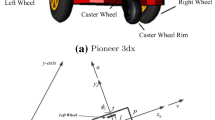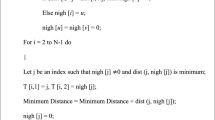Abstract
This research aims to design controllers based on the hedge-algebras (HA) theory to control differential robots that track reference trajectories. First, the HA-based controller (denoted as HA controller) is synthesized by selecting a suitable qualitative control rule base for the investigated model as a rule-based optimization problem. Then, the optimal HA-based controller (denoted as oHA controller) is established based on the problem of simultaneously optimizing the rule base, the reference interval of variables, and the fuzzy parameters of the variables. Optimization problems aim to minimize the distance between the robot and the reference trajectory. The optimization problems in this study use the Balancing composite motion optimization (BCMO) algorithm. A controller based on fuzzy set theory (denoted as FC controller) with the same parameters as the HA controller is also included for comparison. The simulation results show that the HA and oHA controllers demonstrate many advantages over the FC controller regarding reference trajectory tracking ability, calculation time, and control robustness. The main contribution of this work consists of (i) The development of a novel HA, oHA approaches to control a mobile robot to follow reference trajectories accurately; (ii) Providing optimal global-based BCMO in terms of minimal tracking error with computational efficiency; (iii) The investigation of one control rule base for HA and oHA controllers, which is effective for many different reference orbits; (iv) The development of a robust controller that adapts to the robot’s geometric parameters changes; (v) The proposed controllers have superior performance results compared to controllers based on fuzzy set theory in terms of position error between the robot and the reference trajectory, control action calculation time, and robust ability to change robot parameters.



















Similar content being viewed by others
Explore related subjects
Discover the latest articles and news from researchers in related subjects, suggested using machine learning.Data availability
The datasets generated during the current study are available from the corresponding author on reasonable request.
References
Ab Wahab MN, Nefti-Meziani S, Atyabi A (2020) A comparative review on mobile robot path planning: Classical or meta-heuristic methods? Annu Rev Control 50:233–252
Niloy MA, Shama A, Chakrabortty RK, Ryan MJ, Badal FR, Tasneem Z, Ahamed MH, Moyeen SI, Das SK, Ali MF (2021) Critical design and control issues of indoor autonomous mobile robots: a review. IEEE Access 9:35338–35370
Mac TT, Copot C, Tran DT, De Keyser R (2016) Heuristic approaches in robot path planning: a survey. Robot Auton Syst 86:13–28
David J, Manivannan P (2014) Control of truck-trailer mobile robots: a survey. Intell Serv Robot 7:245–258
Siegwart R, Nourbakhsh IR, Scaramuzza D (2011) Introduction to autonomous mobile robots. MIT press
Patle B, Pandey A, Parhi D, Jagadeesh A (2019) A review: on path planning strategies for navigation of mobile robot. Def Technol 15(4):582–606
Mac TT, Hoang VT, Bui H-L, Sy TN, Hoang HH (2021) Design of agriculture robot for tomato plants in green house. In: Regional conference in mechanical manufacturing engineering, Springer, pp 1347–1355
Sy TN, Hong KD, Duc NT, Bui-Hai L, Mac TT (2022) A study on YOLOv4 algorithm for harvesting agriculture robot. In: MMMS2022—the third international conference on material, machines, and methods for sustainable development, Springer
Bui H-L, Cong TT, Quan PA, Mac TT (2021) Surrounding environment detection of an intelligent wheelchair using improved convolutional neural networks. In: Regional conference in mechanical manufacturing engineering. Springer, pp 1238–1245
de Campos Souza PV (2020) Fuzzy neural networks and neuro-fuzzy networks: a review the main techniques and applications used in the literature. Appl Soft Comput 92:106275
Cebollada S, Payá L, Flores M, Peidró A, Reinoso O (2021) A state-of-the-art review on mobile robotics tasks using artificial intelligence and visual data. Expert Syst Appl 167:114195
Londhe PS, Patre B (2019) Adaptive fuzzy sliding mode control for robust trajectory tracking control of an autonomous underwater vehicle. Intell Serv Robot 12:87–102
Moustris GP, Tzafestas SG (2011) Switching fuzzy tracking control for mobile robots under curvature constraints. Control Eng Pract 19(1):45–53
Wang H, Liu W, Zhang F, Yang SX, Zhang L (2015) A GA-fuzzy logic based extended Kalman filter for mobile robot localization. In: 2015 12th international conference on fuzzy systems and knowledge discovery (FSKD). IEEE, pp 319–323
Kuo C-H (2016) Trajectory and heading tracking of a mecanum wheeled robot using fuzzy logic control. In: 2016 international conference on instrumentation, control and automation (ICA). IEEE, pp 54–59
Begnini M, Bertol DW, Martins NA (2017) A robust adaptive fuzzy variable structure tracking control for the wheeled mobile robot: simulation and experimental results. Control Eng Pract 64:27–43
Wu X, Jin P, Zou T, Qi Z, Xiao H, Lou P (2019) Backstepping trajectory tracking based on fuzzy sliding mode control for differential mobile robots. J Intell Rob Syst 96:109–121
Khai TQ, Ryoo Y-J, Gill W-R, Im D-Y (2020) Design of kinematic controller based on parameter tuning by fuzzy inference system for trajectory tracking of differential-drive mobile robot. Int J Fuzzy Syst 22:1972–1978
Abdelwahab M, Parque V, Elbab AMF, Abouelsoud A, Sugano S (2020) Trajectory tracking of wheeled mobile robots using z-number based fuzzy logic. IEEE Access 8:18426–18441
Singhal K, Kumar V, Rana K (2022) Robust trajectory tracking control of non-holonomic wheeled mobile robots using an adaptive fractional order parallel fuzzy PID controller. J Frankl Inst 359(9):4160–4215
Ho NC, Wechler W (1990) Hedge algebras: an algebraic approach to structure of sets of linguistic truth values. Fuzzy Sets Syst 35(3):281–293
Ho NC, Wechler W (1992) Extended hedge algebras and their application to fuzzy logic. Fuzzy Sets Syst 52(3):259–281
Ho NC, Van Long N (2007) Fuzziness measure on complete hedge algebras and quantifying semantics of terms in linear hedge algebras. Fuzzy Sets Syst 158(4):452–471
Ho NC, Lan VN (2008) Optimal hedge-algebras-based controller: design and application. Fuzzy Sets Syst 159(8):968–989
Nguyen CH, Tran DK, Van Nam H, Nguyen HC (1999) Hedge algebras, linguistic-value logic and their application to fuzzy reasoning. Int J Uncertain Fuzziness Knowl Based Syst 7(04):347–361
Nguyen CH, Pedrycz W, Duong TL, Tran TS (2013) A genetic design of linguistic terms for fuzzy rule based classifiers. Int J Approx Reason 54(1):1–21
Nguyen CH (2015) A discussion on interpretability of linguistic rule based systems and its application to solve regression problems. Knowl Based Syst 88:107–133
Ngo HH, Nguyen CH, Nguyen VQ (2019) Multichannel image contrast enhancement based on linguistic rule-based intensificators. Appl Soft Comput 76:744–762
Nguyen CH, Pham TL, Nguyen TN, Ho CH, Nguyen TA (2021) The linguistic summarization and the interpretability, scalability of fuzzy representations of multilevel semantic structures of word-domains. Microprocess Microsyst 81:103641
Bui H-L, Tran N-A, Cao HQ (2023) Active control based on hedge-algebras theory of seismic-excited buildings with upgraded tuned liquid column damper. J Eng Mech 149(1):04022091
Bui V-B, Mac T-T, Bui H-L (2023) Design optimization considering the stability constraint of the Hedge-algebras-based controller for building structures subjected to seismic excitations. Proc Inst Mech Eng Part I J Syst Control Eng 237(10):1822–1837
Bui H-L (2021) Multi-objective optimization of hedge-algebra-based controllers for quarter-car active suspension models. In: IFToMM Asian conference on mechanism and machine science. Springer, pp 876–885
Mac T-T, Nguyen T-D, Bui H-L, Tran N-A (2023) Optimal design of hedge-algebras-based controller for vibration control of vehicle suspension systems. Proc Inst Mech Eng Part I J Syst Control Eng. https://doi.org/10.1177/09596518231196900
Bui H-L, Pham M-N, Nguyen T-T-H (2022) Swing-up control of an inverted pendulum cart system using the approach of Hedge-algebras theory. Soft Comput 26(10):4613–4627
Khoi PB, Toan NV (2018) Hedge-algebras-based controller for mechanisms of relative manipulation. Int J Precis Eng Manuf 19:377–385
Van Nguyen T, Yi S-Y, Bui Khoi P (2020) Hedge algebras-based admittance controller for safe natural human–robot interaction. Adv Robot 34(24):1546–1558
Bui T-L, Nguyen T-H, Nguyen X-T (2023) A Controller for delta parallel robot based on hedge algebras method. J Robot. https://doi.org/10.1155/2023/2271030
Nguyen S-T, Mac T-T, Bui H-L (2023) Motion control of a mobile robot using the hedge-algebras-based controller. J Robot. https://doi.org/10.1155/2023/6613293
Le-Duc T, Nguyen Q-H, Nguyen-Xuan H (2020) Balancing composite motion optimization. Inf Sci 520:250–270
Bui H-L, Tran N-A (2022) Multi-objective optimal design of TMDs for increasing critical flutter wind speed of bridges. J Wind Eng Ind Aerodyn 225:104992
Klancar G, Zdesar A, Blazic S, Skrjanc I (2017) Wheeled mobile robotics: from fundamentals towards autonomous systems. Butterworth-Heinemann
Nguyen T-D, Bui H-L (2023) General optimization procedure of the Hedge-algebras controller for controlling dynamic systems. Artif Intell Rev 56(3):2749–2784
Bui H-L, Le T-A, Bui V-B (2017) Explicit formula of hedge-algebras-based fuzzy controller and applications in structural vibration control. Appl Soft Comput 60:150–166
Bui H-L, Tran Q-C (2021) A new approach for tuning control rule based on hedge algebras theory and application in structural vibration control. J Vib Control 27(23–24):2686–2700
Zienkiewicz OC, Taylor RL, Zhu JZ (2005) The finite element method: its basis and fundamentals. Elsevier
Bui H-L (2022) An approach for optimizing the hedge-algebras-based controller and application in structural vibration control. In: International conference on engineering research and applications. Springer, pp 157–165
Bui H-L, Nguyen C-H, Vu N-L, Nguyen C-H (2015) General design method of hedge-algebras-based fuzzy controllers and an application for structural active control. Appl Intell 43:251–275
Acknowledgements
This research is funded by Hanoi University of Science and Technology (HUST) under project number T2022-PC-023
Author information
Authors and Affiliations
Corresponding author
Ethics declarations
Conflict of interest
The authors declare that they have no conflict of interest.
Additional information
Publisher's Note
Springer Nature remains neutral with regard to jurisdictional claims in published maps and institutional affiliations.
Appendix
Appendix
This section presents the parameters of the FC controller. The FC controller has the same operating scheme as the HA controller, as shown in Fig. 3. In which the Normalization, HA—Rule Base, HA—Inference, and De-Normalization components are, respectively, replaced by the Fuzzification, FC—Rule Base, FC—Inference, and De-Fuzzification ones.
The reference ranges of the state variables and control variables of the FC controller are also chosen the same as those of the HA controller (id = 18 m, ia = 4.4 rad, and iR = iL = 7 rad/s). The Fuzzification diagrams of the input and output variables are shown in Fig.
A1. The control rule base of the FC controller for ωR is the same as that of the HA controller (see Table 3). The control rule base for ωL is also derived from that for ωR. The geometric representation of these rule bases is plotted in Fig.
A2. The FC—Inference and De-Fuzzification use the Mamdani and centroid methods, respectively.
Rights and permissions
Springer Nature or its licensor (e.g. a society or other partner) holds exclusive rights to this article under a publishing agreement with the author(s) or other rightsholder(s); author self-archiving of the accepted manuscript version of this article is solely governed by the terms of such publishing agreement and applicable law.
About this article
Cite this article
Nguyen, TD., Nguyen, ST., Mac, T.T. et al. Trajectory tracking of mobile robots using hedge-agebras-based controllers. Intel Serv Robotics 17, 793–814 (2024). https://doi.org/10.1007/s11370-024-00529-2
Received:
Accepted:
Published:
Issue Date:
DOI: https://doi.org/10.1007/s11370-024-00529-2






